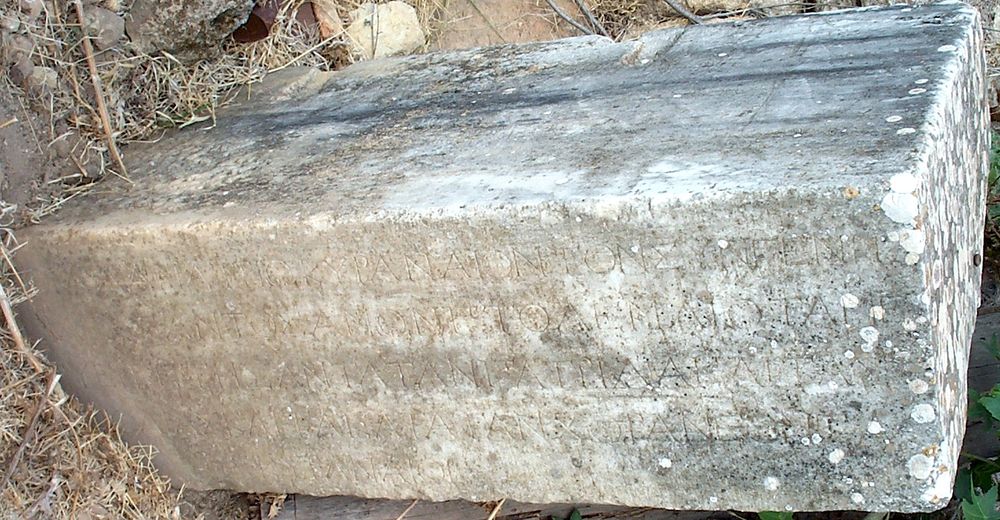EpiDoc XML:
IGCyr0650002
Trismegistos ID:
6189
Source description
Support: White marble plain rectangular base with holes for attachment on the rear edge of the upper face, perhaps related to a reuse (w: 1.30 × h: 0.35 × d: 0.65).
Layout: Ιnscribed on front face.
Letters: 0.033; light serifs, alpha with rather low bar, beta with larger lower loop, kappa with long oblique bars, pi with projecting upper bar, non-slanting sigma.
Date: Between 107 and 75 BC (reign).
Findspot: Found in 1960-1961, probably during the excavations of the Department under Harrison at Cyrene ➚, Valley Street, North Side, built into a late Roman wall.
Last recorded location: Observed by C. Dobias-Lalou in 1983 and 2004 near the findspot, in front of Public Building D.
Text constituted from: Transcription from stone (CDL).
Bibliography
Harrison – Sichtermann 1962, col. 437, fig. 11, whence SEG, 20.729; Reynolds in Vickers – Reynolds 1971-1972, p. 44, fig. 21; Laronde 1987, pp. 421-422, 455, whence SEG, 38.1885; Gasperini 1996, pp. 149-154 (=Gasperini – Arnaldi – Marengo 2008, pp. 370-380), whence SEG, 46.2202; Dobias-Lalou 1999, p. 145, whence SEG, 49.2352; Dobias-Lalou 2000, p. 262, whence SEG, 50.1637; IGCyr 065000 ➚. Cf. Hauben – Van't Dack 1971, p. 35; Habicht 1972, pp. 127-128; Fraser 1972, vol. II, p. 189, n. 81; Mooren 1975, n. 0407; Bagnall 1976, pp. 36-37; Criscuolo 2011, pp. 133-140 and Laronde 2011, p. 60, whence SEG, 61.1552; Rosamilia 2023, p. 38, footnote 178.
Text
French translation
(scil. La statue de) Aiglanor fils de Damatrios, cyrénéen, Parent de Ptolémée qui fut notre roi, à la suite des très grands bienfaits rendus à sa patrie, aux autres cités et aux populations de la campagne, (scil. a été érigée), par les Cyrénéens.
English translation
(scil. The statue of) Aiglanor son of Damatrios, Cyrenaean, Akin to Ptolemy once our king, great benefactor of his home-city, of the other cities and of the people living in the country, (scil. was erected) by the Cyrenaeans.
Italian translation
(scil. La statua di) Aiglanor figlio di Damatrios, cireneo, Parente di Tolemeo che è stato nostro re, per i grandissimi benefici resi alla sua patria, alle altre città e alle popolazioni della campagna, (scil. è stata eretta) dai Cirenei.
Arabic translation
(تمثال) أيغلانور بن داماتريوس، كيريني (أي من كيريني)، مُقربٌ (أي له ما للملك من نفوذ وصلاحيات) لبتوليميوس (بطليموس) مَلِكُنا ذات مرة (حكمنا فترة ما)، مُحْسِن عظيم (كبير) لمدينته وللمدن الأخرى وللناس الذين يعيشون في البلاد (ربما يقصد بها الأرياف)، (نُصِبَ) من قبل الكيرينيين.
Commentary
This honorific inscription is very similar to IGCyr1041002, which has been restored by Laronde as fully parallel. However Gasperini showed that there were some substantial differences.
The common problem is the exact meaning of the aorist participle βασιλεύσαντος: it might refer either to a dead king (Ptolemy IX Soter II or Ptolemy Apion) or to a king who no longer reigned over Cyrenaica (Ptolemy IX Soter II, when he flew to Cyprus in 107 BC).
The question is related to the circumstances when Aiglanor gained his title of syggenes, that is 'akin' to the king. The question was diversely answered by Habicht, Laronde and Criscuolo, who even thought that Ptolemy VIII Euergetes was possible. This view might be, as stressed by Rosamilia 2023, enhanced by the pronoun ἁμῶν, which is meaningful because Ptolemy VIII is the only king amongst them who was for a time king of Cyrene only.
Αἰγλάνωρ, twice honoured in his home-city, high officer of one Ptolemy, was probably the man whose name was misspelled as Αἰγλάτωρ in Plutarchus' and Polyaenus' manuscripts as shown by Habicht.
The stone was found at a place where it was probably reused: it is unclear whether it originally stood in the nearby quarter of the agora or in the Sanctuary of Apollo like IGCyr1041002.
CC BY-NC-SA 4.0 Deed Attribution-NonCommercial-ShareAlike 4.0 International License.
All citation, reuse or distribution of this work must contain a link back to DOI: https://doi.org/10.60760/unibo/igcyrgvcyr2 and the filename (IGCyr000000 or GVCyr000), as well as the year of consultation.



